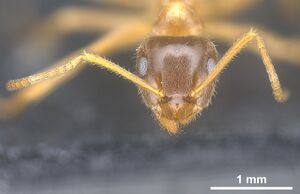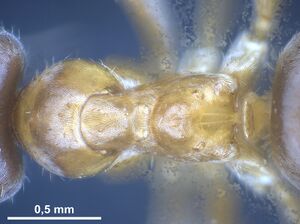Lasius persicus
| Lasius persicus | |
|---|---|

| |
| Scientific classification | |
| Kingdom: | Animalia |
| Phylum: | Arthropoda |
| Class: | Insecta |
| Order: | Hymenoptera |
| Family: | Formicidae |
| Subfamily: | Formicinae |
| Tribe: | Lasiini |
| Genus: | Lasius |
| Section: | niger clade |
| Species group: | niger |
| Species: | L. persicus |
| Binomial name | |
| Lasius persicus Seifert, 2020 | |
The species is associated with humid broad-leafed forest. Most nests located as part of a taxonomic study (Seifert 2020) were found in rotten logs, with a few occurring in the soil.
Identification
Seifert (2020) – Lasius persicus is similar to Lasius grandis and Lasius emarginatus but is distinctive in comparison too other Lasius species found in its range. The most similar sympatric species is Lasius illyricus. Lasius persicus differs from L. illyricus by its longer setae, much higher setae numbers (on the scape and hind tibia in particular), shorter scapes and terminal segments of the maxillary palps, and smaller eyes.
Keys including this Species
Distribution
Seifert (2020) - known from the small band of humid Caspian forest in the northern Iran between 37.7°N, 48.8°E and 36.1°N, 53.2°E at elevations between minus 26 and 1170 m.
Distribution based on Regional Taxon Lists
Palaearctic Region: Iran (type locality).
Distribution based on AntMaps
Distribution based on AntWeb specimens
Check data from AntWeb
Countries Occupied
| Number of countries occupied by this species based on AntWiki Regional Taxon Lists. In general, fewer countries occupied indicates a narrower range, while more countries indicates a more widespread species. |

|
Biology
Castes
Worker
Images from AntWeb
   
| |
| Holotype of Lasius persicus. Worker. Specimen code antweb1041449. Photographer Roland Schultz, uploaded by California Academy of Sciences. | Owned by SMNG, Görlitz, Germany. |
Nomenclature
The following information is derived from Barry Bolton's Online Catalogue of the Ants of the World.
- persicus. Lasius persicus Seifert, 2020: 69, figs. 73-74 (w.) IRAN.
Unless otherwise noted the text for the remainder of this section is reported from the publication that includes the original description.
Description
Medium-sized (CS 908 µm). Head length index medium and scape length rather large (CL/CW900 1.064, SL/ CS900 1.030). Outlines of head in dorsal view more rounded than in Lasius emarginatus, postocular distance significantly larger (PoOc/CL900 0.239), eye smaller (EYE/CS900 0.238). Toruloclypeal distance large (dClAn900 5.33). Terminal segment of maxillary palp of medium length (MP6/CS900 0.192). Number of mandibular dents above-average (MaDe900 8.70). Pubescence on clypeus very dilute (sqPDCL900 5.11) and on whole body smooth; frontal pubescence appressed and of medium length (PLF900 26.7 µm). Whole body and appendages with numerous long setae which are longer than in most of the related species (nOcc900 13.7, nGen900 9.8, nGu900 11.7, nSc900 23.3, nHT900 20.6, nSt900 3.8, PnHL/CS900 0.161, GuHL/CS900 0.140). Coloration: Mandibles, clypeus, antennae, legs, mesosoma, petiole, and frontal face of first gaster segment light orange brown; remaining gaster dark brown, vertex medium brown with orange tinge.
Abbreviations given above for measurements, ratios and functions are defined here: Seifert 2020 Lasius characters. Also see table 7 in Seifert 2020 for morphometric measurements, ratios, and functions.
Type Material
Holotype and 2 paratype workers on two pins labelled ”IRAN:36.5006°N,51.9346°E Nur, Abpari forest, 318m, forest floor, in rotten log O.Paknia 2008.06.24 -2673“; 3 paratype workers on one pin labelled ”IRAN:36.5020°N,51.9322°E Nur, Abpari forest, 315m, forest floor, in rotten log Paknia 2008.06.23 -2795“; 3 paratype workers on one pin labelled ”IRAN:36.50067°N,51.9345°E Nur, Abpari forest, 318m, forest floor, in rotten log Paknia 2008.06.22 -2993“; depository Staatliches Museum für Naturkunde Görlitz.
Etymology
The name refers to the terra typica where the species has been found.
References
- Menchetti, M., Schifani, E., Alicata, A., Vila, R. 2023. Quantitative morphology and mtDNA reveal that Lasius maltaeus is not endemic to the Maltese Islands (Hymenoptera, Formicidae). Journal of Hymenoptera Research 95, 129–142 (doi:10.3897/jhr.95.96365).
- Seifert, B. 2020. A taxonomic revision of the Palaearctic members of the subgenus Lasius s.str. (Hymenoptera, Formicidae). Soil Organisms 92(1): 15-86 (doi:10.25674/so92iss1pp15).

